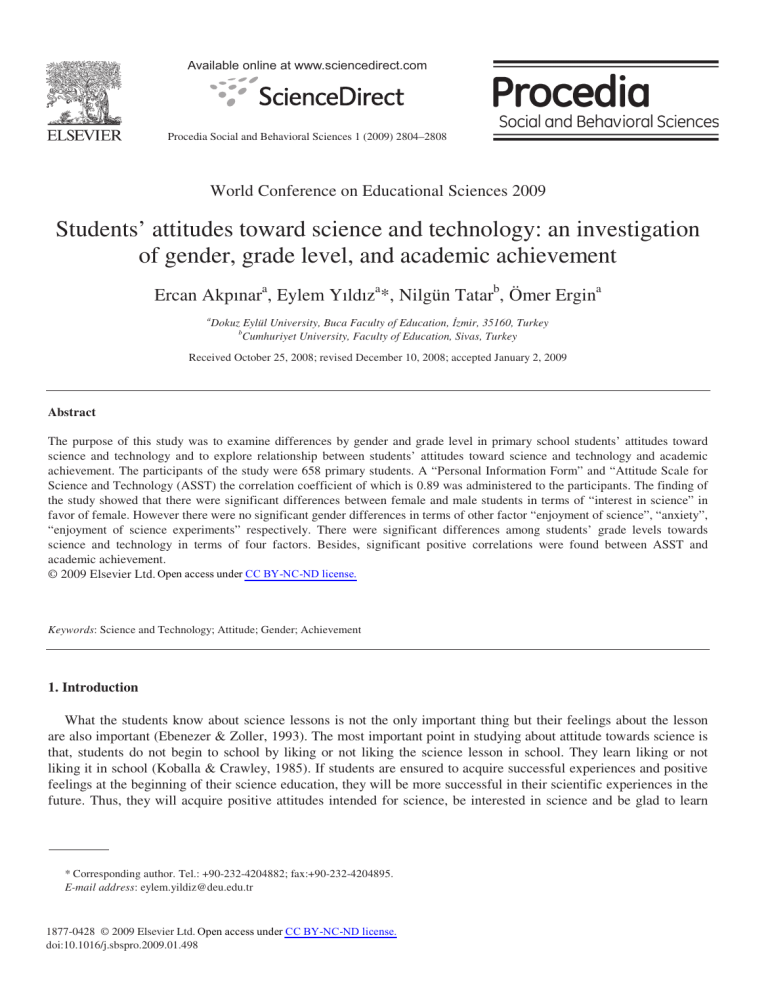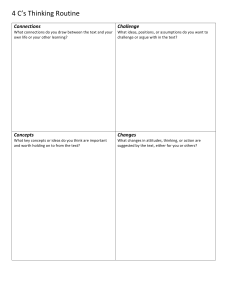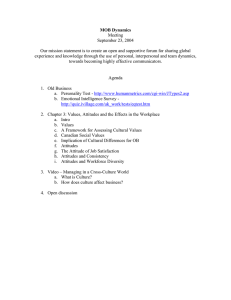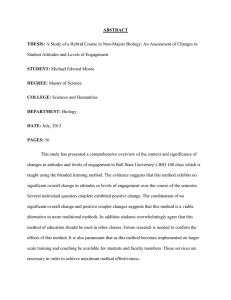Students' Attitudes Toward Science & Technology: Gender & Grade
advertisement

Available online at www.sciencedirect.com Procedia Social and Behavioral Sciences 1 (2009) 2804–2808 World Conference on Educational Sciences 2009 Students’ attitudes toward science and technology: an investigation of gender, grade level, and academic achievement Ercan Akpınara, Eylem Yıldıza*, Nilgün Tatarb, Ömer Ergina a Dokuz Eylül University, Buca Faculty of Education, øzmir, 35160, Turkey b Cumhuriyet University, Faculty of Education, Sivas, Turkey Received October 25, 2008; revised December 10, 2008; accepted January 2, 2009 Abstract The purpose of this study was to examine differences by gender and grade level in primary school students’ attitudes toward science and technology and to explore relationship between students’ attitudes toward science and technology and academic achievement. The participants of the study were 658 primary students. A “Personal Information Form” and “Attitude Scale for Science and Technology (ASST) the correlation coefficient of which is 0.89 was administered to the participants. The finding of the study showed that there were significant differences between female and male students in terms of “interest in science” in favor of female. However there were no significant gender differences in terms of other factor “enjoyment of science”, “anxiety”, “enjoyment of science experiments” respectively. There were significant differences among students’ grade levels towards science and technology in terms of four factors. Besides, significant positive correlations were found between ASST and academic achievement. © 2009 Elsevier Ltd. Open access under CC BY-NC-ND license. Keywords: Science and Technology; Attitude; Gender; Achievement 1. Introduction What the students know about science lessons is not the only important thing but their feelings about the lesson are also important (Ebenezer & Zoller, 1993). The most important point in studying about attitude towards science is that, students do not begin to school by liking or not liking the science lesson in school. They learn liking or not liking it in school (Koballa & Crawley, 1985). If students are ensured to acquire successful experiences and positive feelings at the beginning of their science education, they will be more successful in their scientific experiences in the future. Thus, they will acquire positive attitudes intended for science, be interested in science and be glad to learn * Corresponding author. Tel.: +90-232-4204882; fax:+90-232-4204895. E-mail address: eylem.yildiz@deu.edu.tr 1877-0428 © 2009 Elsevier Ltd. Open access under CC BY-NC-ND license. doi:10.1016/j.sbspro.2009.01.498 Ercan Akpınar et al. / Procedia Social and Behavioral Sciences 1 (2009) 2804–2808 2805 science during all their lifecycles. However, if they have negative experiences in science lessons, they will avoid science and develop negative attitudes toward science in rest of their lives (Simpson & Oliver, 1990). According to George (2006), attitudes towards science and science teaching are issues with longstanding attention and interest in science education research. A concern for many countries is the falling numbers of students choosing to pursue the study of science, alongside the increasing recognition of the importance and economic utility of scientific knowledge. Therefore the investigation of students’ attitudes towards studying science has been a substantive feature of the work of the science education research community for the past 30–40 years (Osborne, Simon & Collins, 2003). According to the studies on science education, there is a series of studies determining attitudes of primary school students for science and technology and examining its relation with various variables. In some of these studies, the relation between students’ attitudes toward science and their academic achievement as well as learning strategies was examined (Genç, 2001; Oruç, 1993; Tepe, 1999; Turhan, 2003). In general, positive, low or moderate relationships for students of primary school (r =0,24, 0,42, 0,48, 0,73) and moderate relationship for students of secondary school (r =0,61) found between students’ academic achievement and their attitudes toward science. Other studies researched whether grade level are effective on the attitude towards science. Some of the studies were found that students’ attitude towards science lessons increased as their grade increased (Alkan, 2006; Çakır, ùenler & Taúkın, 2007 Ilgaz, 2006;; Tepe, 1999). However other studies have contradictory results showing students’ attitude towards science lessons increased as their grade decreased (Geroge, 2006; Külçe, 2005; Weinburg, 2000). The major finding of the studies could be stated as “more positive attitudes toward science are associated with more positive attitudes about the utility of science. The question of gender differences in attitudes toward science has been also addressed. Results of these studies are twofold: Attitudes towards science lesson did not vary between genders (Çakır, ùenler and Taúkın, 2007; Ilgaz, 2006; Külçe, 2005; Neathery, 1997; Turhan, 2003). Although there were no significant differences between the attitudes toward science according to gender, Neathery (1997) stated that male students rated science as a subject more exciting than female students in elementary and secondary schools. The second fold is a meaningful variation is seen between girls’ and boys’ attitudes toward science lesson (Alkan, 2006; Miller, Blessing and Schwartz, 2006; Akbudak, 2005; Genç, 2001; Weinburgh, 2000). In the study of Miller, Blessing and Schwartz (2006) themes emerged from responses on the rating scales and questionnaire are even when females planned to major in science, they were more interested than males in the people-oriented aspects of their planned majors. Females often planned a science major mainly because they needed a science background in order to enter a health profession such as medicine or physical therapy. Females generally found science uninteresting and the scientific lifestyle (as perceived by them) unattractive. The differences emerged from the study of Weinburg (2000) is that males are more positive in their enjoyment of science, motivation in science, and self-concept of science whereas the females are more positive in their perception of the science teacher and the value of science to society. Taking into consideration the results of the above-mentioned studies, it can be said that there are differences between the results of the studies conducted to determine the effects of gender, grade level and achievement of students on their attitudes towards science. Therefore, it is important to examine whether positive attitudes toward science influence achievement in science (George, 2006). In the present study, some variables in primary school students’ (6th, 7th and 8th grades) attitudes toward science and technology and factors affecting these attitudes were examined. The purpose of this study was to examine differences by gender and grade level in primary school students’ attitudes toward science and to explore relationship between students’, attitudes toward science and academic achievement. The main questions being asked in this study are: 1. Do primary students exhibit different attitudes toward science according to gender? 2. Do primary students exhibit different attitudes toward science according to grade level? 3. Is there a correlation between students’ attitudes toward science and academic achievement? 2. Methods Survey method was followed in this study. The participants of the study were 658 grades six, seven and eight students. The sample was approximately 50% female (n =333) and 44% male (n=325). 2806 Ercan Akpınar et al. / Procedia Social and Behavioral Sciences 1 (2009) 2804–2808 2.1. Instruments A “Personal Information Form” and “Attitude Scale for Science and Technology” the correlation coefficient of which is 0.89 was administered to the participants. In the first stage of the study, a scale “Attitude Scale for Science and Technology” (ASST) consisted of 41 items was developed by the researchers by revising and referring to some studies regarding science and technology scales (; Cho, Kim, & Choi, 2003; Wallace, 1997; Pell & Jarvis, 2001). The each item was answered in of 5-category Likert-type response format ranging from strongly agree (5 point) to strongly disagree (1 point) and negatively worded items were reversed scored. Exploratory factor analysis was conducted to determine the construct validity of the questionnaire. Principal components factor analysis followed by varimax rotation. A four-factor structure emerged from the analysis. The first factor, labeled Enjoyment of Science (n=8), second factor labeled Anxiety of Science (n=7), third factor labeled Interest in Science (n=3), and fourth factor labeled Enjoyment of Science Experiments (n=3). These four factors accounted for 44.98% of the total variance, and each showed high internal consistency (Į = .85 for enjoyment of science, Į =.80 for anxiety of science, Į =.71 for interest in science and Į =.78 for enjoyment of science experiments). The overall scale reliability (21 items) was calculated as 0.89. In order to assess demographic variables of the participants, it was used A Personal Information Form. This form consisted of three items. In these items students were asked to indicate their genders, grade levels and course grades as a measure of academic achievement 3. Results Gender Differences Table 1 Independent samples t-test comparing males and females in terms of the ASST’s four factors. Factors Gender N Mean SD Factors Enjoyment of science Female 333 30.36 6.36 Interest science Male 325 29.48 7.43 Female 333 25.32 6.10 Male 325 25.14 6.00 Anxiety Enjoyment of science experiments in Gender N Mean SD Female 333 12.61 2.49 Male 325 11.82 2.90 Female 333 12.92 2.74 Male 325 12.66 3.036 *p<0.001 Table 1 showed that there was significant difference between female and male students in terms of “interest in science” in favor of female (t=3.74, p=.000) and there were no significant gender differences in terms of other factor “enjoyment of science” (t=1.62, p=104), “anxiety” (t=.38, p=.704), “enjoyment of science experiments” (t=1.14, p=.255). 3.2. Grade Levels Differences In order to see whether the students’ attitudes towards science and technology varied in accordance with the grade levels, a one-way between-groups ANOVA followed by Scheffe post hoc test was used. Table 2 provides the descriptive statistics regarding grade levels. As the Table 2 suggests, the means were seem to differ from each other in terms of the factors according to the grade levels. In the analysis of variance (ANOVA) results, there were significant differences among students’ grade levels towards science and technology in terms of four factors. Significant value of four factors (“enjoyment of science”, “anxiety”, “interest in science”, “enjoyment of science experiments”) are F=28.62, p=.000; F=16.42; p=.000; F=11.70, p=.000; F=35.33, p=.000 respectively. Scheffe test showed that there was a significant grade level difference between 6th and 8th grade in favor of 6th grade students in terms of all factors. There was also significant difference between 7 grade level and 8 grade one in favor of 7 grade students in terms of four factors. 2807 Ercan Akpınar et al. / Procedia Social and Behavioral Sciences 1 (2009) 2804–2808 Table 2 Descriptive statistics regarding grade levels. Factors Grade N Mean SD Factors Grade N Mean SD Enjoyment of science 6th 194 32,09 5,50 Interest in science 6th 194 12,70 2,31 7th 185 31,03 6,23 7th 185 12,61 2,45 8th 279 27,69 7,57 8th 279 11,63 3,06 6th 194 26,52 5,60 6th 194 13,66 2,03 7th 185 26,18 5,65 7th 185 13,47 2,09 8th 279 23,69 6,28 8th 279 11,74 3,47 Anxiety Enjoyment of science experiments 3.3. Correlations among ASTS and academic achievement Significant positive correlations were found between ASTS and academic achievement (r=.502, p=.000). 4. Conclusion and Discussion The purpose of this study was to examine differences by gender and grade level in primary school students’ attitudes toward science and to explore relationship between students’ attitudes toward science and academic achievement. Gender results showed that there was a significant difference between female and male students in terms of “interest in science” in favor of female. Considering other factors (enjoyment of science, anxiety”, enjoyment of science experiments); compared with boys, girls tend to have positive attitudes toward science course. However, this difference is not statistically significant. This shows that girls develop more positive attitudes towards science when compared to the boys. Similar results were obtained in other studies (Alkan, 2006; Çakır, ùenler & Taúkın, 2007) as well. On the other hand, other studies on gender and attitude have produced different results. While some studies have not revealed any statistically significant difference between boys and girls, some other studies have put forward statistically significant difference in favor of boys (Neathery, 1997). Examination of students’ attitudes toward science and technology on the basis of grade level, it was observed that student attitudes tended to decline while grade level increased and that a considerable decline was recorded in the attitudes of particularly 8th grade students compared to other grade levels. Some studies on attitude and grade level have also produced similar results (Geroge, 2006; Külçe, 2005; Weinburg 2000). George (2006) stated that the decline in attitudes could be related to the type of science courses taken by students in each grade. In the upper grades, science is often taught as a group of facts and vocabulary words that are to be memorized and not as a way of investigation (Weinburg, 2000). It may be that the natural curiosity of children has been dampened as they move through the grades. This is a common problem for many countries. The reasons behind this problem can be listed as science curriculum, ineffective teaching methods and techniques, the belief that science is a difficult course and the factors related with parents and social life. These reasons affect not only current but also future learning experiences. Another reason of this situation can be the fact that 8th grade students prepare for “High School Entrance Examination” (Çakır, ùenler & Taúkın, 2007). Analysis of the relationship between achievement and attitude revealed a mid-level, positive relationship. Similar results were also obtained in the other studies (Oruç, 1993; Tepe, 1999). In the light of these results, it can be suggested that students with high science achievement develop positive attitudes towards science as well. It is recommended that future studies should focus on analyzing together the variables such as self-efficacy, motivation and anxiety, which are considered to be related with attitudes. 2808 Ercan Akpınar et al. / Procedia Social and Behavioral Sciences 1 (2009) 2804–2808 References Akbudak, Y. (2005). ølkö÷retim 7. sınıf ö÷rencilerinin fen bilgisi dersine ve ö÷retimine iliúkin tutumları ve önerileri. Yayınlanmamıú yüksek lisans tezi. Selçuk Üniversitesi, Sosyal Bilimler Enstitüsü Alkan, A. (2006). ølkö÷retim ö÷rencilerinin fen bilgisine karúı tutumları. Yayınlanmamıú yüksek lisans tezi. Afyon Kocatepe Üniversitesi, Sosyal Bilimler Enstitüsü. Çakır, N.K., ùenler, B. & Taúkın, B.G. (2007). ølkö÷retim II. kademe ö÷rencilerinin fen bilgisi dersine yönelik tutumlarının belirlenmesi. Türk E÷itim Bilimleri Dergisi, 5(4), 637–655. Cho, H., Kim, J. & Choi, D. H. (2003). Early childhood teachers’ attitudes toward science teaching: a scale validation study. Educational Research Quarterly. 27 (2), 33-42. Ebenezer, V.J. & Zoller, U. (1993). Grade 10 students’ perceptions of attitudes toward science teaching and school science. Journal of Research in Science Teaching. 30 (2), 175–186. Genç, M. (2001). ølkö÷retim Okullarının ikinci kademesindeki ö÷rencilerin fen bilgisi dersine karúı tutumlarının de÷erlendirilmesi. Yayınlanmamıú yüksek lisans tezi. Celal Bayar Üniversitesi, Fen Bilimleri Enstitüsü. George, R. (2006). A cross-domain analysis of change in students’ attitudes toward science and attitudes about the utility of science. International Journal of Science Education, 28 (6), 571–589. Güzel, H. (2004). Genel fizik ve matematik derslerindeki baúarı ile matemati÷e karúı olan tutum arasındaki iliúki. Türk Fen E÷itimi Dergisi. 1 (1), 49–58. Ilgaz, G. (2006). ølkö÷retim II. kademe ö÷rencilerinin fen bilgisi dersine yönelik tutumları ve kullandıkları ö÷renme stratejileri. Yayınlanmamıú yüksek lisans tezi. Trakya Üniversitesi, Sosyal Bilimler Enstitüsü. Koballa, R. T & Crawley, E. F. (1985). The influence of attitude on science teaching and learning. School Science and Mathematics. 85 (83), 222–232. Külçe, C. (2005). ølkö÷retim ö÷rencilerinin fen bilgisi dersine yönelik tutumları. Yayınlanmamıú Yüksek Lisans Tezi. Pamukkale Üniversitesi, Fen Bilimleri Enstitüsü. Miller, P.H., Blessing, J.S. & Schwartz, S. (2006). Gender differences in high-school students’ views about science. International Journal of Science Education, 28 (4), 363–381. Neathery, M.F. (1997). Elementary and secondary students’ perceptions toward science and the correlation with gender, ethnicity, ability, grade, and science achievement. Electronic Journal of Science Education [Online]. Available: http://unr.edu/homepage/jcannon/ejse/ejsev2n1.html Oruç, M. (1993). ølkö÷retim okulu II. kademe ö÷rencilerinin fen tutumları ile fen baúarıları arasındaki iliúki. Yayınlanmamıú yüksek lisans tezi. Hacettepe Üniversitesi, Fen Bilimleri Enstitüsü. Osborne, J. Simon, S. & Collins, S. (2003). Attitudes towards science: A review of the literature and its implications. International Journal of Science Education, 25 (9), 1049–1079. Pell, T. & Jarvis, T. (2001). Developing attitude to science scales for use with children of ages from five to eleven years. International Journal of Science Education, 23, 847-862. Simpson, D. R. & Oliver, S. J. (1990). A summary of major influences on attitude toward and achievement in science among adolescent students. Science Education. 74 (1), 1–18. Smist, J.M., Archambault, F.X. & Owen, S.V. (1994). Gender and ethnic differences in attitude toward science and science self-efficacy among high school students. Paper presented at the annual meeting of the American Educational Research Association, San Francisco, CA. Tavúancıl, E. (2002). Tutumların Ölçülmesi ve SPSS ile Veri Analizi. Ankara: Nobel yayın da÷ıtım. Tepe, D. (1999). Ö÷rencilerin fen derslerine karúı tutumları ile baúarıları arasındaki iliúki. Yayınlanmamıú yüksek lisans tezi. Marmara Üniversitesi, Fen Bilimleri Enstitüsü. Turhan, F. (2003). ølkö÷retim sekizinci sınıf ö÷rencilerinin fen bilgisi baúarısını etkileyen bazı faktörler. Yayınlanmamıú yüksek lisans tezi. Gazi Üniversitesi E÷itim Bilimleri Enstitüsü. Wallace, R.S. (1997). Structural equation model of the relationships among inquiry-based instruction, attitudes toward science, achievement in science and gender. Northon Illinois University. Unpublished PhD Dissertation. Weinburgh, M.H. (2000). Gender, ethnicity, and grade level as predictors of middle school students’ attitudes toward science. ERIC, ED442662.





